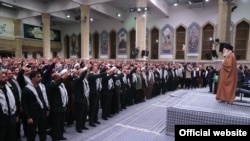Iran's State TV has quoted an official from the country's Supreme National Security Council as having denied a report by Reuters that the leader of the Islamic Republic Ali Khamenei himself issued the order for the crackdown that killed some 1,500 Iranian protesters in mid-November.
Alireza Zarifian, a public relations officer at the SNSC predictably ruled out the Reuters report as "fake news," but failed to present an accurate casualty figure.
Zarifian further categorized the report in the Iranian government's typical jargon as "psychological warfare." He added that Reuters' report cannot be duly fact-checked, and that it does harm to Reuters credibility as a news agency.
But the news of the unprecedented number of protesters killed by security forces and Reuters reporting that Supreme Leader Khamenei ordered the crackdown have shaken Iranians and will have a lasting impact.
Reuters had said in a special report on December 23 that " After days of protests across Iran last month, Supreme Leader Ayatollah Ali Khamenei appeared impatient. Gathering his top security and government officials together, he issued an order: Do whatever it takes to stop them."
Responding to demands from within the government and on social media for transparent reporting on the number of protesters killed by security forces, Iranian officials have been saying that the figures were being "checked and categorized" based on the reasons of death and other factors. In other words, they have refused to release even partial figures.
Conflicting reports on the number of those who were killed during the crackdown is natural in a non-transparent media environment like Iran. It appears that what has annoyed some Iranian officials is that after a month of media campaign by major Iranian media outlets including the state TV to blame the Rouhani administration for the fatal crackdown, the new report points fingers at Supreme Leader Ayatollah Ali Khamenei.
The Iranian government has never published accurate figures on the number of those killed in the 2017-2018 protests, the 2009 unrest, the 1999 student protest and many other anti-government demonstrations before, after and in between those events.
Adding insult to injury, the government categorically denies responsibility for the murders and charges that demonstrators killed each other, as Interior Minister Rahmani Fazli and many IRGC commanders have said about the mid-November crackdown.
While the government rules out reports by reliable sources such as Amnesty International (that has put the number of confirmed deaths so far at 304) and Reuters, angry Iranians on social media have a different opinion.
One social media user wrote: "The Islamic Republic has killed 1,500 in 4 days. That makes 375 per day which is way more than 61 per day casualty toll in the Iran-Iraq war of the 1980s." He concluded that Khamenei has killed Iranians six times more than Saddam Hussain did.
Besides the shocking number of casualties Reuters has uncovered, another consequential revelation is the Supreme Leader’s responsibility in given the green light for the massacre.
Iranian journalist Kayvan Hosseini wrote that "If the figure is right, the November massacre will become a legacy of the leader of the Islamic Republic."
Therefore, it is an extremely important fact that Iranian government officials have revealed Khamenei’s role to Reuters. This is an unprecedented event and might point to discord and factional rivalry among the elite at the extreme.
Iranian analyst Ali Hossein Ghazizadeh recalled a Newsweek headline that said ISIS will take over if the Islamic Republic falls and wrote that "ISIS could have hardly managed to kill 1,500 in just three days."
This is what will remain in the collective memory of the populace. Ayatollah Khamenei’s image can hardly recover from this burden.
Iranian journalist Nik Kowsar wrote: "If true, it's a sign of desperation of a ruthless regime."
Iranian Human Rights Lawyer Shadi Sadr explained the reason for conflicting reports on the number of casualties. She wrote: "The figure given by Reuters is significant," adding that "Human rights organizations have managed to confirm only some 400 deaths as family members fear punishment by the government if they disclose death cases.
Activist Mohammad Mozaffari tweeting a photo of Khamenei doctored to look like Adolf Hitler, wrote: "This is a 21st century genocide. The world must not remain silent in the face of this crime."






